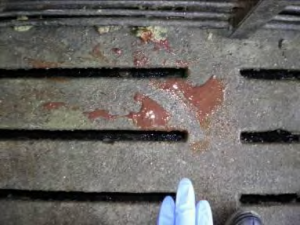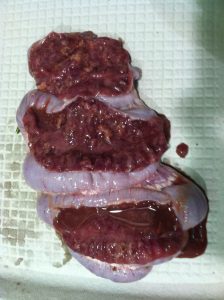Enteric System: Post-Weaning Pigs
Swine dysentery and brachyspiral colitis
Clinical importance
Brachyspira spp. Causes enteric symptoms of variable severity in swine. The most severe is swine dysentery characterized by hemorrhagic, mucoid diarrhea in growing pigs, caused most commonly by the bacteria Brachyspira hyodysenteriae, or the recently isolated Brachyspira hampsonii. By comparison, Brachyspira pilosicoli causes mild to moderate diarrhea in growing pigs. Swine dysentery can cause major economic loss in a herd, both through death loss and reduced daily growth rate. While the disease still persists, it is considered under control in the United States.
Etiology and Transmission
Brachyspira spp. is an anaerobic bacteria species known for their snake-like appearance. The species Brachyspira hyodysenteriae can evolve relatively quickly, resulting in a large number of strains that can vary farm-to-farm. The disease is spread via the fecal-oral route. Brachyspira hyodysenteriae is a hardy bacteria and can survive for periods up to 2 months in fecal matter. Therefore, it can also be spread via contaminated boots or clothing. Transmission occurs most often pig-to-pig or through contaminated equipment. Additionally, Brachyspira hyodysenteriae can infect rodents which become asymptomatic carriers of the bacteria.
Associated symptoms
Farrow-to-finish farms or partially slatted barns are most likely to be positive for swine dysentery. The first noticeable symptoms are gray to yellow diarrhea in growing pigs. In the next stage of the disease, as fast as a few hours after the beginning of the clinical signs, pigs will display mucus and fresh blood in their stools, that are quite characteristic of the pathogen. Just like with any other diarrhea, pigs become dehydrated and experience decreased daily gain that can persist even when the pigs recover. Mortality can be severe, up to 30% if left untreated.

Associated lesions

Macroscopic lesions
At necropsy, edema occurring in the large intestine can be noted in the early stages of infection. Later on, a thick, fibrinous, hemorrhagic mucus can be found on the surface of the colon.
Microscopic lesions
Inflammation and hyperplasia of the crypt cells can occur within the colon in acute cases. Leukocytes are also present in increased numbers in the mucosa, while neutrophils center around the capillaries. Pseudomembranes made of fibrin may also form on the mucosa.
What is the most characteristic lesion associated with swine dysentery?
- Pseudomembranes in the small intestine
- Thickening of the ileum
- Mucus and fresh blood in the spiral colon
Diagnosis
Untreated animals that have just began to show symptoms are the best source for sample collection, as this is the peak level of bacteria in the feces. Fecal samples, fecal swabs or colon tissue are the best samples. Anaerobic culture is still considered the gold standard for the diagnosis of swine dysentery but a PCR test on oral fluids or fecal samples can also be used.
Differential Diagnosis
Differential diagnosis of diarrhea in growing pigs should include salmonellosis and ileitis. Blood in the intestine can also be indicative of an ulcer (melena or of hemorrhagic bowel syndrome.
What is the best diagnostic test for swine dysentery?
- Anaerobic culture of feces
- PCR test on oral fluids
- ELISA test on serum
Treatment, Prevention and Control
The number of effective treatments for swine dysentery is decreasing, as antibiotic resistance is becoming a major problem. Therefore, a susceptibility panel should be run before selecting an antibiotic. Typically, tiamulin administered in the herd’s water proves to be an effective herd treatment. If the pig is in danger of dying, however, injection can be used.
The environment is the main source of reinfected pigs, so infected area should be thoroughly cleaned and disinfected in between batches of pigs. Stringent biosecurity measures, such as protective clothing and rodent control are necessary to maintain a negative herd. Vaccines have not proven cost efficient enough to be used regularly. Eradication of swine dysentery is possible either by depopulation of the herd or with a combination of medication, cleaning and disinfection techniques, and strict biosecurity measures.
Which of the following is NOT of concern for the eradication of swine dysentery?
- Presence of rodents on the farm
- Partially-slatted concrete floors
- All-in, all-out management of the barn
- Antimicrobial treatment without a susceptibility panel

